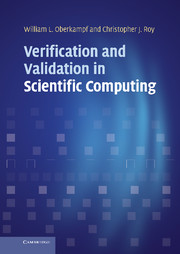Book contents
- Frontmatter
- Contents
- Preface
- Acknowledgments
- 1 Introduction
- Part I Fundamental concepts
- Part II Code verification
- Part III Solution verification
- Part IV Model validation and prediction
- 10 Model validation fundamentals
- 11 Design and execution of validation experiments
- 12 Model accuracy assessment
- 13 Predictive capability
- Part V Planning, management, and implementation issues
- Appendix Programming practices
- Index
- Plate Section
- References
11 - Design and execution of validation experiments
from Part IV - Model validation and prediction
Published online by Cambridge University Press: 05 March 2013
- Frontmatter
- Contents
- Preface
- Acknowledgments
- 1 Introduction
- Part I Fundamental concepts
- Part II Code verification
- Part III Solution verification
- Part IV Model validation and prediction
- 10 Model validation fundamentals
- 11 Design and execution of validation experiments
- 12 Model accuracy assessment
- 13 Predictive capability
- Part V Planning, management, and implementation issues
- Appendix Programming practices
- Index
- Plate Section
- References
Summary
Chapter 10, Model validation fundamentals, discussed the philosophy of validation experiments and how they differ from traditional experiments as well as calibration experiments. A validation experiment is conducted for the primary purpose of determining the predictive accuracy of a mathematical model. In other words, a validation experiment is designed, executed, and analyzed for the purpose of quantitatively determining the ability of a mathematical model and its embodiment in a computer code to simulate a well-characterized physical process. In this chapter we describe six primary guidelines for the design and execution of validation experiments. Our discussion will also deal with how these guidelines can be carried out and why they are sometimes difficult to execute in practice.
We will then discuss a high-quality validation experiment that the authors, as well as several others, designed and executed. The experiment is referred to as the Joint Computational/Experimental Aerodynamics Program (JCEAP). From the beginning of the project, it was designed to synergistically couple computational fluid dynamics development and an experimental research in a hypersonic wind tunnel. The program was initiated in 1990 at Sandia National Laboratories and came to a successful close in 1997. The program helped develop the six fundamental guidelines for the design and execution of high-quality validation experiments. We use JCEAP to exemplify these six guidelines and make recommendations for how they can be applied to validation experiments in general.
- Type
- Chapter
- Information
- Verification and Validation in Scientific Computing , pp. 409 - 468Publisher: Cambridge University PressPrint publication year: 2010
References
- 5
- Cited by

